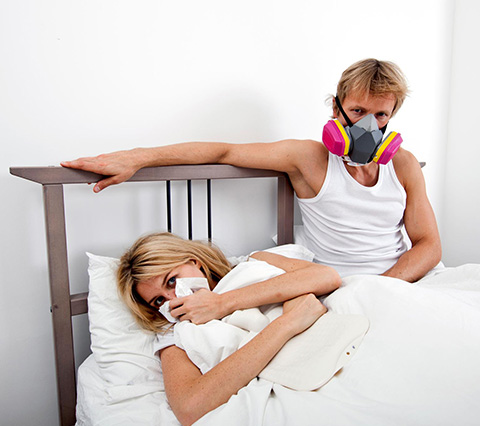Is Your Home Making You Sick? Part 1: Carbon Monoxide
October 21, 2016

We all know carbon monoxide is dangerous, but do you know the warning signs? If you heat with a combustion system -- oil, gas, propane, or even wood and charcoal -- you run the risk of having a carbon monoxide buildup in your home that can be uncomfortable, dangerous, or even deadly.
A Real Life Issue
Today, we ran into such an issue. While we were running our health and safety checks before starting an insulation job, our homeowners' heating system failed our Combustion Safety Tests. They had a woodstove removed from their home that was no longer being used. The opening into the chimney was never blocked, so all of the CO from their heating system was dumping into the home through that hole rather than venting out the chimney top. In short, they were pumping poisonous gas directly into their living space.
What Is It and How Does it Happen?
Carbon monoxide is a colorless, odorless gas that is a natural byproduct of combustion. If there's fire, there's CO. A well-functioning boiler or furnace is built to whisk these fumes out of your home, but if your heating system is malfunctioning, it can spill right into your home. Now that it's getting cooler and we're kicking on our heat for the first time in months, you could be facing spillage or combustion problems that may not have existed last April.
Do You Know The Warning Signs?
The Mayo Clinic warns that the following persistent symptoms could indicate early CO poisoning:
- Dull headache
- Weakness
- Dizziness
- Nausea or vomiting
- Shortness of breath
- Confusion
- Blurred vision
- Loss of consciousness
Today's homeowners explained to our crews that they had been experiencing severe headaches and nausea for days but never attributed it to a home safety issue. Carbon monoxide can lead to tissue and brain damage or death. It's particularly dangerous for children, the elderly, and unborn babies, but it's life-threatening no matter who you are.
How to Avoid CO Poisoning
- First and foremost, make sure you have carbon monoxide detectors. If they start beeping, don't assume they're malfunctioning! If your detectors are beeping, open some windows, leave the home, and call 911 to report a CO alarm. In our home today, the CO detectors had gone off previously but the homeowners removed the batteries because they thought they were malfunctioning.
- Have your combustion systems properly vented and serviced annually by your gas company or a reputable technician. Any time you make a change to or around your heating system or other combustion unit (gas heaters, gas fireplaces, portable generators), make sure to have it tested for safety.
Today's homeowners are very lucky that health and safety is such an important aspect of the Mass Save program and that our crews knew exactly what to do in an emergency situation. If you have concerns for either the health and safety of your home or your energy efficiency, an energy assessment will uncover problems with both. CT and MA residents can
contact us Monday - Friday for an assessment through our website or by calling (888) 840-6641.
Stay safe this heating season!
 We all know carbon monoxide is dangerous, but do you know the warning signs? If you heat with a combustion system -- oil, gas, propane, or even wood and charcoal -- you run the risk of having a carbon monoxide buildup in your home that can be uncomfortable, dangerous, or even deadly.
We all know carbon monoxide is dangerous, but do you know the warning signs? If you heat with a combustion system -- oil, gas, propane, or even wood and charcoal -- you run the risk of having a carbon monoxide buildup in your home that can be uncomfortable, dangerous, or even deadly.